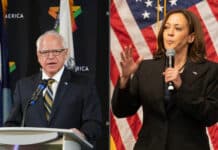The Minneapolis City Council unanimously decided last week that law enforcement officers shouldn’t be armed when conducting traffic stops.
The 13-member body approved a resolution authored by Council Member Phillipe Cunningham that aims to create “an unarmed Traffic Safety Division to be housed in a department outside of the Police Department.”
“This new division is to be responsible for enforcement,” the resolution states.
While Cunningham is “thrilled” by the recent development, skeptics worry that disarming traffic officers will limit their flexibility and reduce their safety, all while addressing an issue that does not exist.
Traffic stops are the most common point of contact Americans have with police, per the Bureau of Justice Statistics. Each year, there are about 20 million traffic stops. When police aren’t responding to a call, investigating a crime, writing a report or testifying before a court, they’re monitoring the streets. This enables cops to take a proactive role in looking for and disrupting crime rather than simply cleaning up after it.
These armed police roving our streets remove a sense of safety that criminals otherwise enjoy. During riots around the “Free State of George Floyd” where there are no police patrols, criminals operate freely — as too many grieving families of dead Minnesotans must surely understand.
Further, during the time that Minneapolis police stopped pulling people over during the unrest that followed George Floyd’s death, murders and violent crime skyrocketed. It is exceedingly difficult to prove causation in any case, but this is surely a correlation at least.
At any time, a law enforcement unit that is watching a roadway to catch speeders might also notice a stolen vehicle or a car registered to somebody with a warrant. Police cruisers are often equipped with technology that automatically alerts them to such vehicles in their vicinity for this exact purpose. Keeping cops armed enables them to rapidly transition roles, putting down the radar gun and picking up a regular one to apprehend a suspect if needed.
Creating an unarmed traffic enforcement service would require Minneapolis to fund two cruisers to do the job of one. Rather than having a single unit that can enforce traffic laws and perform other law enforcement functions, the city would have to field separate vehicles to accomplish each of these aims.
Additionally, if an unarmed traffic unit were to initiate a stop that evolves into a more advanced situation, they would be unequipped to deal with it. About 30% of roadside searches reveal drivers carrying contraband. If an unarmed traffic enforcer were to happen upon a suspect carrying drugs, what is stopping the suspect from simply shoving the officer and driving away? Much worse, if a suspect is found to possess a contraband weapon, what can the officer use to defend himself?
People respect authority because, to paraphrase a leftist academic, the state has a monopoly on the legitimate use of force. Take away an authority’s ability to use force (a gun), and the authority evaporates, leaving only a person with a blue shirt and a ticket book.
By creating two separate law enforcement entities, one to perform traffic stops and another to be the armed police, Minneapolis would not only complicate law enforcement, but create an effectively meaningless, vestigial liability that could not deal with dire situations or defend itself.
What’s more: the city seems to be solving an issue that doesn’t exist.
During the entirety of last year, 121 people were killed by police during traffic stops — not 121 innocent people, not 121 black people, but 121 people total.
121 is not a small number of lives, but it’s important to maintain perspective. America is a country of 350 million individuals. Police initiate about 55,000 traffic stops per day. The overwhelming majority of the 121 Americans killed during those stops were likely armed or chose to escalate conflict. The mainstream media does an outstanding job finding and publicizing stories where police shoot suspects without proper justification, but there were not 121 of these stories related to traffic stops last year!
Police do pull over minorities at a higher rate than whites. However, a case can be made that this is because minorities commit significantly more crime per capita, per the FBI, not because police are intentionally harassing those communities.
Daunte Wright died because of a combination of his own escalation and disgusting officer incompetence. Philando Castile was probably not reaching for a gun after he informed officers that he was legally carrying, which he did not even have to do per state law. While these traffic-stop deaths are unfortunate, it would also be unfortunate to allow Minneapolis to field unnecessary and ineffective new law enforcement units.
The people of Minneapolis do not need “an unarmed Traffic Safety Division.” They need leadership that will better train and equip existing officers to deal with crime.


















